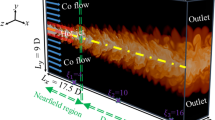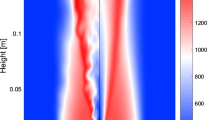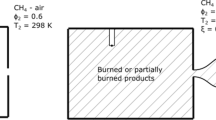Abstract
The effects of turbulence on knock development and intensity for a thermally inhomogeneous stoichiometric ethanol/air mixture at a representative end-gas autoignition condition in internal combustion engines are investigated using direct numerical simulations with a skeletal reaction mechanism. Two- and three-dimensional simulations are performed by varying the most energetic length scale of temperature, \(l_T\), and its relative ratio with the most energetic length scale of turbulence, \(l_T/l_e\), together with two different levels of the turbulent velocity fluctuation, \(u'\). It is found that \(l_T\)/\(l_e\) and the ratio of ignition delay time to eddy-turnover time, \(\tau _{ig}/\tau _t\), are the key parameters that control the detonation development. An increase in either \(l_T\) or \(l_e\) enhances the detonation propensity by allowing a longer run-up distance for the detonation development. The characteristic length scale of the temperature field, \(l_T\), is significantly modified by high turbulence intensity achieved by a large \(l_e\) and \(u'\). The intense turbulence mixing effectively distributes the initial temperature field to broader scales to support the developing detonation waves, thereby increasing the likelihood of the detonation formation. On the contrary, high turbulence intensity with a short mixing time scale, achieved by a small \(l_e\) and a large \(u'\), reduces the super-knock intensity attributed to the finer broken-up structures of detonation waves. Either \(\tau _{ig}/\tau _t\) less than unity or \(l_e = l_T\) even with a large \(u'\) is found to have no significant effect on super-knock mitigation. Finally, high turbulent intensity may induce high-pressure spikes comparable to the von Neumann spike. Increased temperature and pressure by combustion heating, noticeably after the peak of heat release rate, significantly enhance the collision and interaction of multiple emerging autoignition fronts near the ending combustion process, resulting in localized high-pressure spikes.













Similar content being viewed by others
Change history
30 June 2020
The article ‘Effects of Turbulence and Temperature Fluctuations on Knock Development in an Ethanol/Air Mixture’, written by Minh Bau Luong, Swapnil Desai, Francisco E. Hernández Pérez, Ramanan Sankaran, Bengt Johansson, and Hong G. Im was originally published electronically on the publisher’s internet portal (currently SpringerLink) on 29th May 2020 with open access.
Abbreviations
- 0-D, 1-D, 2-D, and 3-D:
-
Zero-dimensional, one-dimensional, two-dimensional, and three-dimensional
- DNS:
-
Direct numerical simulation
- ICE:
-
Internal combustion engine
- LIF:
-
Laser-induced fluorescence
- HCCI:
-
Homogeneous-charge compression ignition
- HRR:
-
Heat release rate
- NTC:
-
Negative-temperature coefficient
- RMS:
-
Root mean square
- SI:
-
Spark-ignited
- PDF:
-
Probability density function
- a :
-
Sound speed
- BL:
-
Baseline cases with no turbulence
- L, E, and G:
-
Denote three levels of \(\tau _{ig}/\tau _t\) being less than, equal to, and greater than unity, respectively
- \((.)^{l_e}_{l_T}\) :
-
The subscript and superscript correspond to the most energetic length scale of temperature, \(l_T\), and turbulent velocity field, \(l_e\), respectively
- \(F_H\) :
-
Fraction of HRR of the regions with pressure greater than \(P_e\)
- \(F_{CJ}\) :
-
Fraction of HRR of the regions with pressure greater than \(P_{CJ}\)
- \(F_{VN}\) :
-
Fraction of HRR of the regions with pressure greater than \(P_{VN}\)
- \(l_t\) :
-
The most energetic length scale of turbulence
- \(l_T\) :
-
The most energetic length scale of temperature
- \(\phi _0\) :
-
Initial mean equivalence ratio
- \(\phi '\) :
-
Root mean square (RMS) equivalence ratio fluctuation
- \(P_{CJ}\) :
-
Chapman–Jouguet pressure
- \(P_e\) :
-
Homogeneous constant-volume equilibrium pressure
- \(P_{max}\) :
-
Maximum pressure over the computational domain
- \(P_{VN}\) :
-
Von Neumann pressure (spike)
- \(\dot{q}\) :
-
Heat release rate
- \(S_L\) :
-
Laminar flame speed
- \(S_{sp}\) :
-
Spontaneous ignition front speed
- \(\tau _{ig}\) :
-
Ignition delay time
- \(\tau _{ig}^0\) :
-
Zero-dimensional homogeneous ignition delay time
- \(\tau _{ex}\) :
-
Excitation time
- T, P, and \(\phi\) :
-
Temperature, pressure, and equivalence ratio
- \(T_0\) :
-
Initial mean temperature
- \(T'\) :
-
Root mean square (RMS) temperature fluctuation
- \(P_0\) :
-
Initial mean pressure
- \(\xi\) :
-
Non-dimensional number defined as the ratio of the speed of sound to the spontaneous ignition front speed, \(\xi = a/S_{sp}\)
- \(u'\) :
-
Root mean square (RMS) velocity fluctuation
- \(\varepsilon\) :
-
Non-dimensional number defined as the ratio of the acoustic residence time, \(r_{hs}/a\), within the hot spot with a radius \(r_{hs}\), to the excitation time, \(\tau _{ex}\), \(\varepsilon = (r_{hs}/a)/\tau _{ex}\)
- \(V_{CJ}\) :
-
Chapman–Jouguet speed
References
Akkerman, V., Ivanov, M., Bychkov, V.: Turbulent flow produced by piston motion in a spark-ignition engine. Flow Turbul. Combust. 82, 317–337 (2009)
Ali, M.J.M., Luong, M.B., Sow, A., Hernández Pérez, F.E., Im, H.G.: Probabilistic approach to predict abnormal combustion in spark ignition engines. SAE paper 2018–01–1722 (2018)
An, Y., Jaasim, M., Vallinayagam, R., Vedharaj, S., Im, H.G., Johansson, B.: Numerical simulation of combustion and soot under partially premixed combustion of low-octane gasoline. Fuel 211, 420–431 (2018)
Bansal, G., Im, H.G.: Autoignition and front propagation in low temperature combustion engine environments. Combust. Flame 158, 2105–2112 (2011)
Bansal, G., Mascarenhas, A., Chen, J.H.: Direct numerical simulations of autoignition in stratified dimethyl-ether (DME)/air turbulent mixtures. Combust. Flame 162, 688–702 (2015)
Bates, L., Bradley, D.: Deflagrative, auto-ignitive, and detonative propagation regimes in engines. Combust. Flame 175, 118–122 (2017)
Bates, L., Bradley, D., Paczko, G., Peters, N.: Engine hot spots: modes of auto-ignition and reaction propagation. Combust. Flame 166, 80–85 (2016)
Bhagatwala, A., Lu, T., Chen, J.H.: Direct numerical simulations of HCCI/SACI with ethanol. Combust. Flame 161, 1826–1841 (2014)
Bhagatwala, A., Sankaran, R., Kokjohn, S., Chen, J.H.: Numerical investigation of spontaneous flame propagation under RCCI conditions. Combust. Flame 162, 3412–3426 (2015)
Bradley, D., Morley, C., Gu, X.J., Emerson, D.R.: Amplified pressure waves during autoignition: relevance to CAI engines. SAE Technical Paper 2002–01–2868 (2002)
Chen, J.H., Hawkes, E.R., Sankaran, R., Mason, S.D., Im, H.G.: Direct numerical simulation of ignition front propagation in a constant volume with temperature inhomogeneities: I. Fundamental analysis and diagnostics. Combust. Flame 145, 128–144 (2006)
Chen, L., Wei, H., Chen, C., Feng, D., Zhou, L., Pan, J.: Numerical investigations on the effects of turbulence intensity on knocking combustion in a downsized gasoline engine. Energy 166, 318–325 (2019)
Dai, P., Chen, Z., Chen, S., Ju, Y.: Numerical experiments on reaction front propagation in n-heptane/air mixture with temperature gradient. Proc. Combust. Inst. 35, 3045–3052 (2015)
Dai, P., Qi, C., Chen, Z.: Effects of initial temperature on autoignition and detonation development in dimethyl ether/air mixtures with temperature gradient. Proc. Combust. Inst. 36, 3643–3650 (2017)
Dec, J.E.: Advanced compression-ignition combustion for high efficiency and ultra-low NOx and soot. In: Crolla, T.K.D., Foster, D.E., Vaughan, N. (eds.) Encyclopedia of Automotive Engineering, pp. 1–40. Wiley, Hoboken (2014)
Desai, S., Yu, J.K., Song, W., Luong, M.B., Hernández Pérez, F.E., Sankaran, R., Im, H.G.: Direct numerical simulations of reacting flows with shock waves and stiff chemistry using many-core/GPU acceleration. Submitted to Computers and Fluids (2018)
Desai, S., Sankaran, R., Im, H.G.: Unsteady deflagration speed of an auto-ignitive dimethyl-ether (DME)/air mixture at stratified conditions. Proc. Combust. Inst. 37, 4717–4727 (2019)
Desai, S., Sankaran, R., Im, H.G.: Auto-ignitive deflagration speed of methane (CH4) blended dimethyl-ether (DME)/air mixtures at stratified conditions. Combust. Flame 211, 377–391 (2020)
El-Asrag, H.A., Ju, Y.: Direct numerical simulations of exhaust gas recirculation effect on multistage autoignition in the negative temperature combustion regime for stratified HCCI flow conditions by using H2O2 addition. Combust. Theory Model. 17, 316–334 (2013)
El-Asrag, H.A., Ju, Y.: Direct numerical simulations of NOx effect on multistage autoignition of DME/air mixture in the negative temperature coefficient regime for stratified HCCI engine conditions. Combust. Flame 161, 256–269 (2014)
Figueroa-Labastida, M., Badra, J., Elbaz, A.M., Farooq, A.: Shock tube studies of ethanol preignition. Combust. Flame 198, 176–185 (2018)
Funk, C., Sick, V., Reuss, D.L., Dahm, W.J.A.: Turbulence properties of high and low swirl in-cylinder flows. SAE Paper 2002–01–2841 (2002)
Gu, X., Emerson, D., Bradley, D.: Modes of reaction front propagation from hot spots. Combust. Flame 133, 63–74 (2003)
Gupta, S., Im, H.G., Valorani, M.: Classification of ignition regimes in HCCI combustion using computational singular perturbation. Proc. Combust. Inst. 33, 2991–2999 (2011)
Hawkes, E.R., Sankaran, R., Pébay, P., Chen, J.H.: Direct numerical simulation of ignition front propagation in a constant volume with temperature inhomogeneities: II. Parametric study. Combust. Flame 145, 145–159 (2006)
Hernández Pérez, F.E., Mukhadiyev, N., Xu, X., Sow, A., Lee, B.J., Sankaran, R., Im, H.G.: Direct numerical simulations of reacting flows with detailed chemistry using many-core/GPU acceleration. Comput. Fluids 173, 73–79 (2018)
Hindmarsh, A.C., Brown, P.N., Grant, K.E., Lee, S.L., Serban, R., Shumaker, D.E., Woodward, C.S.: SUNDIALS: suite of nonlinear and differential/algebraic equation solvers. ACM Trans. Math. Softw. (TOMS) 31(3), 363–396 (2005)
Im, H.G., Pal, P., Wooldridge, M.S., Mansfield, A.B.: A regime diagram for autoignition of homogeneous reactant mixtures with turbulent velocity and temperature fluctuations. Combust. Sci. Technol. 187, 1263–1275 (2015)
Kaiser, S.A., Schild, M., Schulz, C.: Thermal stratification in an internal combustion engine due to wall heat transfer measured by laser-induced fluorescence. Proc. Combust. Inst. 34, 2911–2919 (2013)
Kalghatgi, G.T., Bradley, D.: Pre-ignition and ‘super-knock’ in turbo-charged spark-ignition engines. Int. J. Engine Res. 13, 399–414 (2012)
Kim, S.O., Luong, M.B., Chen, J.H., Yoo, C.S.: A DNS study of the ignition of lean PRF/air mixtures with temperature in homogeneities under high pressure and intermediate temperature. Combust. Flame 162, 717–726 (2015)
Kokjohn, S.L., Musculus, M.P.B., Reitz, R.D.: Evaluating temperature and fuel stratification for heat-release rate control in a reactivity-controlled compression-ignition engine using optical diagnostics and chemical kinetics modelling. Combust. Flame 162, 2729–2742 (2015)
Luong, M.B., Luo, Z., Lu, T., Chung, S.H., Yoo, C.S.: Direct numerical simulations of the ignition of lean primary reference fuel/air mixtures with temperature inhomogeneities. Combust. Flame 160, 2038–2047 (2013)
Luong, M.B., Yu, G.H., Chung, S.H., Yoo, C.S.: Ignition of a lean PRF/air mixture under RCCI/SCCI conditions: a comparative DNS study. Proc. Combust. Inst. 36, 3623–3631 (2017)
Luong, M.B., Hernández Pérez, F.E., Sow, A., Im, H.G.: Prediction of ignition regimes in DME/air mixtures with temperature and concentration fluctuations. AIAA SciTech 2019 Forum (2019)
Luong, M.B., Hernández Pérez, F.E., Im, H.G.: Prediction of ignition modes of NTC-fuel/air mixtures with temperature and concentration fluctuations. Combust. Flame 213, 382–393 (2020a)
Luong, M.B., Desai, S., Hernández Pérez, F.E., Sankaran, R., Johansson, B., Im, H.G.: A statistical analysis of developing knock intensity in a mixture with temperature inhomogeneities. Proc. Combust. Inst. 37 (2020b)
Lutz, A.E., Kee, R.J., Miller, J.A., Dwyer, H.A., Oppenheim, A.K.: Dynamic effects of autoignition centers for hydrogen and c1,2-hydrocarbon fuels. Symp. (Int.) Combust. 22, 1683–1693 (1989)
Meyer, J.W., Oppenheim, A.K.: On the shock-induced ignition of explosive gases. Symp. (Int.) Combust. 13, 1153–1164 (1971)
Miles, P.C.: Turbulent flow structure in direct-injection, swirl-supported diesel engines. In: Arcoumanis, C., Kamimoto, T. (eds.) Flow and Combustion in Reciprocating Engines. Experimental Fluid Mechanics. Springer, Berlin, Heidelberg (2008)
Mittal, G., Sung, C.-J.: Aerodynamics inside a rapid compression machine. Combust. Flame 145, 160–180 (2006)
Pan, J., Wei, H., Shu, G., Chen, Z., Zhao, P.: The role of low temperature chemistry in combustion mode development under elevated pressures. Combust. Flame 174, 179–193 (2016)
Pal, P., Valorani, M., Arias, P.G., Im, H.G., Wooldridge, M.S., Ciottoli, P.P., Galassi, R.M.: Computational characterization of ignition regimes in a syngas/air mixture with temperature fluctuations. Proc. Combust. Inst. 36, 3705–3716 (2017a)
Pan, J., Wei, H., Shu, G., Chen, R.: Effect of pressure wave disturbance on auto-ignition mode transition and knocking intensity under enclosed conditions. Combust. Flame 185, 63–74 (2017b)
Pan, J., Dong, S., Wei, H., Li, T., Shu, G., Zhou, L.: Temperature gradient induced detonation development inside and outside a hotspot for different fuels. Combust. Flame 205, 269–277 (2019)
Passot, T., Pouquet, A.: Numerical simulation of compressible homogeneous flows in the turbulent regime. J. Fluid Mech. 118, 441–466 (1987)
Peters, N., Kerschgens, B., Paczko, G.: Super-knock prediction using a refined theory of turbulence. SAE Int. J. Engines 6, 953–967 (2013)
Petersen, B.R., Ghandhi, J.B.: High resolution scalar dissipation and turbulence length scale measurements in an internal combustion engine. SAE Int. J. Engines 3, 65–83 (2010)
Robert, A., Richard, S., Colin, O., Martinez, L., De Francqueville, L.: LES prediction and analysis of knocking combustion in a spark ignition engine. Proc. Combust. Inst. 35, 2941–2948 (2015a)
Robert, A., Richard, S., Colin, O., Poinsot, T.: LES study of deflagration to detonation mechanisms in a downsized spark ignition engine. Combust. Flame 162, 2788–2807 (2015b)
Sankaran, R., Im, H.G., Hawkes, E.R., Chen, J.H.: The effects of non-uniform temperature distribution on the ignition of a lean homogeneous hydrogen-air mixture. Proc. Combust. Inst. 30, 875–882 (2005)
Schieß, R., Maas, U.: Analysis of endgas temperature fluctuations in an SI engine by laser-induced fluorescence. Combust. Flame 133, 19–27 (2003)
Söderberg, F., Johansson, B., Lindoff, B.: Wavelet analysis of in-cylinder LDV measurements and correlation against heat-release. SAE Pap. 107, 444–456 (1998)
Sow, A., Lee, B.J., Hernández Pérez, F.E., Im, H.G.: Detonation onset in a thermally stratified constant volume reactor. Proc. Combust. Inst. 37, 3529–3536 (2019)
Tang, Q., Liu, H., Yao, M.: Simultaneous measurement of natural flame luminosity and emission spectra in a RCCI engine under different fuel stratification degrees. SAE Int. J. Engines 10, 1155–1162 (2017)
Terashima, H., Matsugi, A., Koshi, M.: Origin and reactivity of hot-spots in end-gas autoignition with effects of negative temperature coefficients: relevance to pressure wave developments. Combust. Flame 184, 324–334 (2017)
Towery, C.A.Z., Poludnenko, A.Y., Hamlington, P.E.: Detonation initiation by compressible turbulence thermodynamic fluctuations. Combust. Flame 213, 172–183 (2020)
Urtiew, P., Oppenheim, A.: Experimental observations of the transition to detonation in an explosive gas. Proc. R. Soc. London Ser. A 295, 13–28 (1966)
Wang, Y., Rutland, C.J.: Effects of temperature and equivalence ratio on the ignition of n-heptane fuel spray in turbulent flow. Proc. Combust. Inst. 30, 893–900 (2005)
Wang, Z., Liu, H., Reitz, R.D.: Knocking combustion in spark-ignition engines. Prog. Energy Combust. Sci. 61, 78–112 (2017)
Wei, H., Chen, C., Zhou, H., Zhao, W., Ren, Z.: Effect of turbulent mixing on the end gas auto-ignition of n-heptane/air mixtures under IC engine-relevant conditions. Combust. Flame 174, 25–36 (2016)
Wei, H., Chen, C., Shu, G., Liang, X., Zhou, L.: Pressure wave evolution during two hotspots autoignition within end-gas region under internal combustion engine-relevant conditions. Combust. Flame 189, 142–154 (2018)
Yoo, C.S., Lu, T., Chen, J.H., Law, C.K.: Direct numerical simulations of ignition of a lean n-heptane/air mixture with temperature inhomogeneities at constant volume: parametric study. Combust. Flame 158, 1727–1741 (2011)
Yoo, C.S., Luo, Z., Lu, T., Kim, H., Chen, J.H.: A DNS study of ignition characteristics of a lean iso-octane/air mixture under HCCI and SACI conditions. Proc. Combust. Inst. 34, 2985–2993 (2013)
Yu, R., Bai, X.-S.: Direct numerical simulation of lean hydrogen/air auto-ignition in a constant volume enclosure. Combust. Flame 160, 1706–1716 (2013)
Yu, H., Chen, Z.: End-gas autoignition and detonation development in a closed chamber. Combust. Flame 162, 4102–4111 (2015)
Yu, G.H., Luong, M.B., Chung, S.H., Yoo, C.S.: Ignition characteristics of a temporally evolving n-heptane jet in an iso-octane/air stream under RCCI combustion-relevant conditions. Combust. Flame 208, 299–312 (2019)
Zeldovich, Y.B.: Regime classification of an exothermic reaction with nonuniform initial conditions. Combust. Flame 39, 211–214 (1980)
Zhang, T., Sun, W., Wang, L., Ju, Y.: Effects of low-temperature chemistry and turbulent transport on knocking formation for stratified dimethyl ether/air mixtures. Combust. Flame 200, 342–353 (2019)
Zhong, L., Liu, C.: Numerical analysis of end-gas autoignition and pressure oscillation in a downsized SI engine using large eddy simulation. Energies 12, 3909 (2019)
Acknowledgements
This work was sponsored by King Abdullah University of Science and Technology (KAUST) and used the computational resources of the KAUST Supercomputing Laboratory. This manuscript has been authored by UT-Battelle, LLC under Contract No. DE-AC05-00OR22725 with the U.S. Department of Energy. The United States Government retains and the publisher, by accepting the article for publication, acknowledges that the United States Government retains a non-exclusive, paid-up, irrevocable, world-wide license to publish or reproduce the published form of this manuscript, or allow others to do so, for United States Government purposes. The Department of Energy will provide public access to these results of federally sponsored research in accordance with the DOE Public Access Plan (http://energy.gov/downloads/doe-public-access-plan).
Author information
Authors and Affiliations
Corresponding author
Ethics declarations
Conflict of interest
The authors declare that they have no conflict of interest.
Additional information
The article ‘Effects of Turbulence and Temperature Fluctuations on Knock Development in an Ethanol/Air Mixture’, written by Minh Bau Luong, Swapnil Desai, Francisco E. Hernández Pérez, Ramanan Sankaran, Bengt Johansson, and Hong G. Im was orginally published electronically on the publisher’s internet portal (currently SpringerLink) on 29th May 2020 with open access. With the author(s)’ decision to step back from Open Choice, the copyright of the article changed on 29th June 2020 to © Springer Nature B.V. 2020 and the article is forthwith distributed under the terms of copyright. The original article has been corrected.
Rights and permissions
About this article
Cite this article
Luong, M.B., Desai, S., Hernández Pérez, F.E. et al. Effects of Turbulence and Temperature Fluctuations on Knock Development in an Ethanol/Air Mixture. Flow Turbulence Combust 106, 575–595 (2021). https://doi.org/10.1007/s10494-020-00171-9
Received:
Accepted:
Published:
Issue Date:
DOI: https://doi.org/10.1007/s10494-020-00171-9




